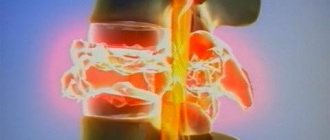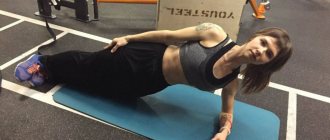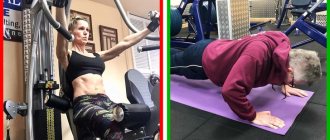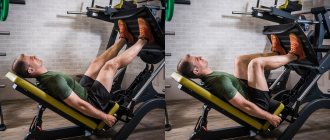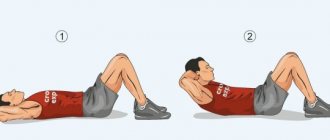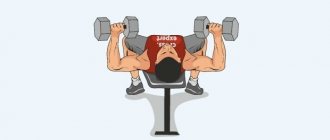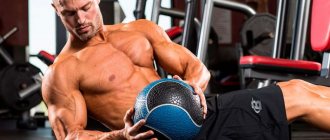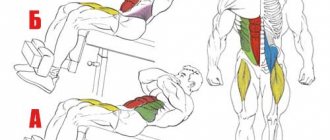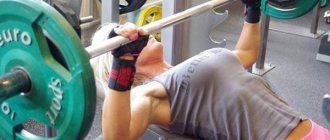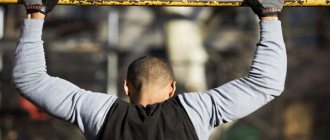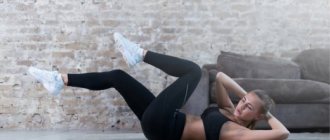Share:
Ab crunches are an exercise performed by athletes to gain strong and sculpted abs. According to its biomechanics, it represents an elevation of the torso with a slight rounding of the back (kyphosis) in the thoracic region from a lying position. As a rule, crunches are not performed by the athlete in the maximum possible amplitude, so that the load is constant and the abdominal muscles do not relax at the top and bottom points. Working in a similar technique, the load is focused on the upper part of the rectus abdominis muscle.
This exercise has gained well-deserved popularity among athletes involved in crossfit, bodybuilding, fitness and martial arts, since a well-developed abdominal press plays an important role in all these disciplines. And today we will tell you how to do crunches correctly - all possible variations of this exercise.
Types of twists[edit | edit code]
Crunches on the floor
Muscles involved
: rectus abdominis, cranial part, in other words “upper abs”, is good for burning fat.
This option is the most common type of crunch and uses all the abdominal muscles. In this case, minimal load is placed on the lower back.
Technique:
Lie face up on the floor, bend your knees at an angle of 90 degrees, place your hands behind your head, and spread your elbows to the sides. Using your abdominal muscles, begin to lift (not jerk) the shoulder girdle from the floor towards the pelvis. From the top point, slowly return to the starting position.
Crunches with rotation
Muscles involved:
abdominal straight lines (mainly the upper part) with an emphasis on the obliques.
Technique:
Using your abdominal muscles, lift your shoulders off the floor and lift your body towards your legs, but do not try to touch your thighs with your forehead or stomach.
At the same time as you rise, slightly turn your torso to the right. Do the next repetition with a left turn. Crunches on a bench with an incline
Crunches on a bench with a downward incline.
Muscles involved:
working out the upper part of the abs.
Technique:
This exercise requires an incline bench. Lie on your back on a bench, bend your knees and place your feet under the support. Place your hands under your head, spread your elbows to the sides. Using your abdominal muscles, begin to lift your upper body and pull it toward your pelvis.
Crunches on the block.
Muscles involved:
abdominal workout, suitable for stimulating muscle growth.
Technique:
Choose a weight that you can do 20 to 25 reps with.
Kneel down facing the pulley device, grab the handle of the pulley and begin to pull it down while bending toward the floor. The abdominal muscles should be in constant tension. Slowly return to the starting position. Side crunches
Side crunches.
Crunches on a block
Muscles involved:
working out the oblique abdominal muscles. This exercise is good for making your waist narrower.
Technique:
Lie sideways on a bench so that the part of your body above your waist extends over the edge and you can freely bend your body up and down. Have someone hold your feet during the exercise. Bend at the waist, slowly lower yourself to the bottom position and just as slowly rise to the starting position. In addition, this exercise can be performed on the floor, lying on your side, resting your elbow on the floor, begin to raise and lower your pelvis.
Recommendations
The most important criticism of professionals is the criticism of the populist opinion that the abs need to be trained for as long as possible. Many people think that by doing 1000 repetitions, they will achieve such success that fitness models cannot dream of.
But this approach is probably only suitable for Shaulin monks who love to do everything unusual, and at times useless.
Anyone who wants to get a beautiful and sculpted stomach should know that this is a muscle like any other.
Straight crunches added to your training program should be based on the same principles as other exercises.
In order for the area to acquire an attractive and beautiful relief, the muscles must grow.
The mechanism for gaining muscle mass is based on the principle of hypercompensation. Therefore, 15-20 repetitions, with a high load, should be enough for one approach.
Otherwise, the fabrics may lose their elasticity, which will make the shape of the cubes unattractive and the posture crooked.
If an athlete has never previously engaged in outdoor sports or trained the abdominal area, he should not force things by using a professional training program.
Due to insufficient strength of muscles, tendons and blood vessels, you can get injured during heavy approaches.
The first week you should not do more than 3 sets of 30 repetitions with your own body. This will allow the tissues to rebuild and prepare for more difficult training.
There are many athletes who, after several months of training, have no results. Their abs remained shapeless, even after they switched to heavy exercises.
This is due to the fact that their cubes are hidden under a layer of fat. To get a truly attractive body, along with going to the gym, you need to think about your diet.
If you are underweight, it is advisable to increase protein intake and the total energy component of the diet; if there is a large amount of adipose tissue, it is recommended to reduce the amount of carbohydrates.
One of the main factors for effective training is the correct abdominal crunch technique.
Only by concentrating all your efforts on tension in a specific area can you get evenly developed muscles.
It is advisable to focus your attention on the smoothness of the movement and full amplitude rather than on the number of repetitions.
Reverse crunches[edit | edit code]
Reverse crunches
Reverse crunches
involve lifting not the torso, but the legs.
Technique:
Lie on the floor and stretch your arms along your torso, or if you are doing this exercise on a bench, grab the edge of it with your hands, as shown in the picture. Bend your knees and lift your hips up until they are perpendicular to the floor. Using your abdominal muscles, pull your knees towards your chest. At the top point of the exercise, the knees should be as close to the chest as possible, and the pelvis should be completely raised above the floor, while trying not to straighten the legs, and do not perform reverse twisting using the thigh muscles.
Benefits of exercise
Crunches bring double benefits - decorative and functional. Exercise helps burn fat and achieve sculpted muscles. But behind the aesthetics lies an even more important reason to work out your abs. Crunches work all the abdominal muscles. Different types of exercise hit one zone or another more accurately. Plus, the muscles of the hips, lower back and even buttocks work.
Strong muscles in this area help stabilize the lower spine. As a result, your posture is corrected. It is even possible to reduce pain, if any, in the spine.
In addition, a developed press provides excellent functionality. You don't have to be a fighter to appreciate the ability to gracefully and easily move through space. The abdominal muscles are located in the central zone and are largely responsible for the comfort of body movements in any direction.
By training the abs, athletes receive a powerful muscle corset, which allows them to increase the stability and rigidity of basic exercises.
Crunches for girls[edit | edit code]
Areas of Muscle Activation When Performing a Basic Crunch Variation
Execution
Lie with your back on the floor, bench or BOSU ball, bend your knees; press your feet to the floor or bench (the latter position will help avoid unwanted flexion of the lower back). Place your hands behind your head.
Slowly, without jerking, lift your shoulders and upper back off the floor. Hold the top position for 2 seconds, keeping your abdominals tense. Slowly return to the starting position and repeat the exercise - smoothly, without jerking.
Since it's easier to tense your muscles when you exhale, exhale as you twist your torso. Inhale as you lower to the starting position. Make sure your head remains in line with your spine.
- Twisting
- Crunch with legs on a bench
Advantage
- Allows you to work out your abdominal muscles without putting excessive strain on your spine.
Flaw
- Has a small range of motion, approximately 15 centimeters. Therefore, it is extremely important to tighten your abdominal muscles as much as possible during each repetition in order to effectively use this limited range of motion.
Do not put pressure on the back of your head when your hands are behind your head. Don't try to make the movement easier. This way you risk damaging your cervical vertebrae.
Recommendations
- You may want to increase your range of motion by lifting your entire torso off the floor. However, this will no longer be twisting, but lifting the body. Here the abdominal muscles play a secondary role, and the lower back bears a greater load. A BOSU ball or curved bench will help increase the range of the curl, thereby increasing the difficulty of the exercise, and also provide additional support for the lower back. We'll present several variations of the sit-up on the following pages, but you should be aware of the dangers this exercise poses to your spine. We recommend replacing lifting with twisting.
- The position of the hands determines the degree of difficulty of the twist. The most difficult exercise to do is with your hands behind your head; It’s easier if you fold your arms crosswise on your chest; and it’s even easier if you stretch your arms out in front of you. Try this combination: start doing the exercise with your hands behind your head; when you get tired, stretch your arms out in front of you and do a few additional exercises.
- Correct hand position, safe for the neck (left); incorrect hand position, unsafe for the neck (right)
- To increase the load, use a barbell disc. Place it behind your head or on your chest. Please note: a barbell plate placed behind the head provides more load than a plate placed on the chest.
- When performing the crunch, do not tilt your head back to look at the ceiling. With your head up, you will arch your back. While performing abdominal exercises, keep your head tilted forward and look at your stomach, but do not lower it too low to avoid straining your neck.
- The exercise will become easier if you extend your arms.
- Recommendations for proper exercise performance
Options with fixed legs[edit | edit code]
- Performing crunches with your legs secured will increase the curvature of the lower back and the stress on the intervertebral discs. Research shows that when performing crunches and sit-ups with your legs attached, the rectus muscles and hip flexors are more active.
- Areas of Muscle Activation When Performing Leg Crunches
- Options with fixed legs
- If you are doing the exercise on an incline bench rather than on the floor, to increase the load, you will need to brace your legs to stabilize your body. The greater the angle of the bench, the higher the load on the abdominal muscles during lifting of the body.
- Areas of muscle activation when doing incline crunches or sit-ups
- Raising the body on an incline bench
Options for obliques[edit | edit code]
- To more actively engage the obliques while doing the crunch, you can lift your torso and rotate it to the side. As mentioned before, an easier version of the exercise is with outstretched arms, a more difficult one is with your hands behind your head. It is also easier to perform the exercise if your feet are on the floor, and more difficult if your feet are raised. To work the oblique abdominal muscles on the left side, while lifting your torso, gently stretch the elbow of your right hand towards the knee of your left leg. Don't try to touch your elbow to your knee. This is impossible; the movement usually stops about halfway. Hold the top position for 2 seconds, then lower. To maintain constant abdominal tension, do not lower yourself to the starting position, but stop a few centimeters from the floor. After completing the exercise on the left side, repeat it on the right side.
- In addition, you can not keep your legs motionless, but bring them closer to your body in sync with the rotation of your shoulders. This is the so-called “Bicycle” - a complex version of twisting. In this case, the oblique abdominal muscles contract more intensely than in other options.
- Areas of Muscle Activation When Performing Crunches for Obliques
- Crunch for obliques with arms extended (easy version)
- Twisting for obliques with legs raised and arms behind head (difficult version) and “Bicycle”
Options on simulators[edit | edit code]
- Unfortunately, many abdominal exercise machines are poorly designed. If you find a machine that allows you to work your abdominal muscles intensely, use it. If you feel discomfort while exercising on the machine, especially in the lumbar region, limit yourself to crunches. A good simulator allows you to choose an individual level of load.
- To perform crunches, you can use a cable machine set in the high position to modulate the load. This will add variety to your workouts.
- Some devices designed for home abdominal muscle training, such as a rocking chair, have a successful design and can easily replace exercise equipment.
- Crunching on a machine
- Crunching on a cable machine and with a rocking chair
Number of repetitions
As stated earlier, effectiveness does not depend on the number of repetitions. The required amount will depend on how correctly you follow the technique and what tension you managed to achieve.
If for some people 10 correctly performed repetitions are enough to feel a burning sensation in the abdominal area, then for others this number can be 50 or 100. That is, the selection of the number is a purely individual matter.
Basically, it all depends on the number of approaches and the time it takes to complete the approach. To intensively work out the abs, it needs to be given as much load as possible in as little time as possible.
Errors when performing twisting[edit | edit code]
| Source: Fitness for Beginners . Manual, 3rd ed. Author: Liz Neporent, 2017 |
Let's look at the most common mistakes that occur during abdominal exercises in order to do them correctly and with maximum benefit.
Rice. 1. Twisting the abdominal muscles. Raising yourself above the floor, keep your head, neck and arms in the same position at all times.
Incorrect twisting of the abdominal muscles[edit | edit code]
Many people complain that their neck begins to hurt after twisting. Of course, this is quite possible, but only if you lift the upper body using the neck muscles, and not by tensing the abdominal muscles. Another mistake is that some people try to lift their torso completely straight, instead of bending it slightly. How do you know if you're performing abdominal crunches correctly? Lift your shoulder blades, shoulders and neck up and hold this position for a couple of seconds. Your torso should be slightly bent, resembling the letter C. For more details, see photo A in fig. 1. And finally, the third mistake is that while twisting the stomach, some people forget about proper breathing.
Proper abdominal curl[edit | edit code]
To avoid sudden movements of the neck, place your hands behind your head, but do not interlock your fingers. Spread your elbows wide and relax your shoulders. If, when you squint your eyes to the side, you cannot see the tips of your elbows, then you are holding your hands correctly. As you rise above the floor, keep your head, neck and arms in the same position at all times. If your torso is in a properly rounded position, your head, neck and lower back will feel almost weightless. In addition, do not forget about breathing: when lifting your torso up, exhale strongly through your mouth, and when lowering to the floor, inhale through your nose (photo B in Fig. 1).
Read also[edit | edit code]
- Press exercises and training features
- Abdominal exercises for girls
- Forward Bend Twist
- Crunches in the simulator
- Crunches on a fitball
- Twisting with body rotation
- Twisting with body rotation
- Twisting with body lift on an incline bench
- Raising the body from a lying position
- Double twist
- Two-stage twisting
- Diagonal twist
- Straight twist
- Combined twist
- Side crunches
- Reverse crunch on the ball
Contraindications
Most twisting techniques are safe. But there are still medical restrictions to this exercise:
- intervertebral and abdominal hernia;
- untreated musculoskeletal injuries;
- adhesive disease;
- recovery period after major operations;
- rheumatism;
- diseases associated with increased intra-abdominal pressure.
If you have the listed diseases, you can perform crunches only with the permission of a doctor. Don't ignore a visit to a specialist. Otherwise, you may harm yourself.
Successful and safe training!
